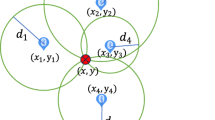Abstract
How to obtain accurate position of sensor node is still a challenging problem for wireless sensor networks (WSNs). This work concentrates on the problem of node localization with mobile anchor node, which is applied to broadcast beacon packets in the region of interest (ROI). Node localization scheme SAA-ERL (speed adaptive adjustment-energy ratio localization) for WSNs is realized in way of interactive communications. SAA scheme determines the suitable moving speed and direction for the mobile anchor node, while the ERL mechanism generates virtual hyper-spheres to help unknown nodes acquire their locations. Based on the quantitative analysis of the localizing performances, the guidelines for system parameters are obtained. Simulation results validate that when system parameters are jointly designed, SAA-ERL can be adapted to scenarios of diversified applications.
Similar content being viewed by others
References
Hung Chi C. and Rong Hong J. (2007). A GPS-less, outdoor, self-positioning method for wireless sensor networks. Ad Hoc Networks 5: 547–557
Akyildiz L. F., Wei Lian S., Sankarasubramaniam Y. and Cayirci E. (2002). A survey on sensor networks. IEEE Communications Magazine 40(8): 102–114
Benbadis, F., Friedman, T., Amorim, M., & Fdida, S. (2005). GPS-free positioning system for wireless sensor networks. In Proceedings of the 2nd IFIP international conference wireless and optical communications networks, pp. 541–545.
Bergamo, P., & Mazzini, G. (2002). Localization in sensor networks with fading and mobility. In Proceedings of the 13th IEEE internatinal symposium on personal, indoor and mobile radio communications (Vol. 2, pp. 750–754).
Bulusu N., Heidemann J. and Estrin D. (2000). GPS-less low cost outdoor localization for very small devices. IEEE Personal Communications 7(5): 28–34
Capkun, S., Hamdi, M., & Hubaux, J. P. (2001). GPS-free positioning in mobile ad-hoc networks. In Proceedings of the 34th annual Hawaii international conference system sciences.
He, T., Blum, B. M., Stankovic, J. A., & Abdelzaher, T. (2003). Range-free localization schemes for large scale sensor networks. In Proceedings of the 9th annual internationall conference mobile computing and networking (Mobicom), pp. 81–95.
Girod, L., & Estrin, D. (2001). Robust range estimation using acoustic and multimodal sensing. In Proceedings of IEEE/RSJ conference intelligent robots and systems (Vol. 3, pp. 1312–1320).
Drane C., Macnaughtan M. and Scott C. (1998). Positioning GSM telephones. IEEE Communications Magazine 36: 46–54
Voddiek M., Wiebking L., Gulden P., Wieghardt J., Hoffmann C. and Heide P. (2004). Wireless local positioning. IEEE Microwave Magazine 4: 77–86
Niculescu, D., & Nath, B. (2003). Ad hoc positioning system (APS) using AOA. In Proceedings of the 22th annual joint conference of the IEEE computer and communications societies (Vol. 3, pp. 1734–1743).
Bahl, P., & Padmanabhan, V. N. (2000). RADAR: An in-building RF-based user location and tracking system. In Proceedings of the 19th annual joint conference of the IEEE computer and communications societies (Vol. 2, pp. 775–784).
Niculescu D. and Nath B. (2003). DV based positioning in ad hoc networks. Telecommunication Systems 22: 267–280
Zhao F., Ma Y., Luo H. Y., Lin Q. and Lin L. (2009). A mobile beacon-assisted node localization algorithm using network-density-based clustering for wireless sensor networks. Journal of Electronics & Information Technology 31(12): 2988–2992
Li S. J., Xu C. F., Yang Y. and Pan Y. H. (2008). Getting mobile beacon path for sensor localization. Journal of Software 19(2): 455–467
Kinsler L., Frey A., Coppens A. and Sanders J. (1982). Fundamentals of acoustics. Wiley, New York, NY, USA
Li Zhi, Y., Chuan, F., Rozenblit, J. W., & Hai Yan, Q. (2006). Adaptive tracking in distributed wireless sensor networks. In Proceedings of 13th annual IEEE international symposium and workshop on engineering of computer based systems.
Liang, B. & Zygmunt, J. H. (1999). Predictive distance-based mobility management for PCS networks. In Proceedings of IEEE information communications conference (INFOCOM’99), pp. 1377–1384.
Author information
Authors and Affiliations
Corresponding author
Rights and permissions
About this article
Cite this article
Xue, L., Yang, B., Guan, X. et al. An Interactive and Energy-efficient Node Localization Scheme for Wireless Sensor Networks. Wireless Pers Commun 69, 1481–1502 (2013). https://doi.org/10.1007/s11277-012-0646-y
Published:
Issue Date:
DOI: https://doi.org/10.1007/s11277-012-0646-y




